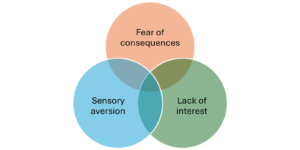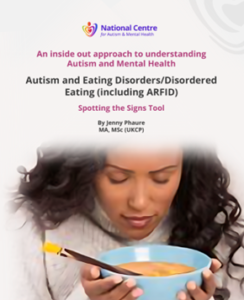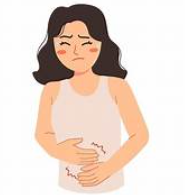What is ARFID and are autistic people more likely to experience it?

What is ARFID?
Avoidant Restricted Food Intake Disorder (ARFID) is classified in the Feeding and Eating Disorders section of the Diagnostic and Statistical Manual – 5 (APA, 2013).
People with ARFID will usually limit the amount and variety of foods they eat. Unlike other eating disorders, food avoidance or restriction is not related to fears around body weight, shape or size. ARFID is therefore characterised by low nutritional state and limited food consumption.
Though ARFID most commonly develops during infancy or early childhood, it can persist into adulthood or develop at any age.

Are autistic people more likely to experience ARFID?
A study in 2019 found that avoidant and restricted food practices were the main type of eating-disorder experienced by Autistic children, young people (this could be ARFID or Atypical Anorexia Nervosa, restricting type).
This included:
- Limited food preferences (88%) followed by hypersensitivity to food texture (46%) and brand loyalty (eating the same brand of food every day such as Mc Cains Chips) which often links to the need for sameness and a dislike of change.
- High levels of pocketing, not swallowing food. This is a practice often found in the early years amongst children being weaned onto more lumpy textures. And lastly Pica at 12% – the eating of non-nutritious and no- food substances.
It is also interesting to note that for autistic children who had atypical eating behaviours, 25% had three or more atypical behaviours. It was only autistic children that had Pica or pocketed food.
Eating difficulties are five times more likely amongst autistic children and young people. Around 70% of parents with Autistic children express concerns about eating difficulties.

What are the risks associated with ARFID?
Although many children go through phases of selective eating, the ARFID diet may be so limited it leads to medical, nutritional, and/or psychosocial problems.
This can lead to significant weight loss, or stalled growth; nutritional deficiencies and interference in relationships or engagement in school or work due to difficulties with eating.
How might ARFID present? (spotting the signs)
Some signs of ARIFD can include:
- Aversion to milk in the early years
- Projectile vomiting in infants
- Problems with weaning (particularly at the point of widening food choices, tastes and textures).
- Highly selective/restricted eating from an early age (this may be maintained through childhood and into adulthood, improve during latency and reappear in puberty when life stressors increase – particularly amongst diagnosed or undiagnosed autistic young people).
- Sensory sensitivities to certain foods (e.g. strong reactions to certain tastes, textures and smells)
- Dislike of change leading to aversions to foods that don’t look or taste the same all the time. This can lead to eating foods that don’t change shape, texture, colour etc (may restrict many fruits and vegetables leading to nutritional deficiencies).
- Food cycling around a very restricted range of foods (eating the same food each day, then dropping this food and moving onto another food and cycling through a restricted range of foods). This can be linked to sensory sensitivities in relation to food groups and may be exacerbated under stress.
- Food aversion linked to feared consequences of eating (e.g. choking or vomiting).

Physical signs
The physical signs of ARFID will vary based around the individuals eating pattern. Some physical signs and medical consequences may include:
- Dramatic weight loss or faltering growth
- Dresses in layers to hide weight loss or stay warm
- Constipation, abdominal pain, cold intolerance, lethargy, and/or excess energy
- Gastrointestinal issues (“upset stomach”, feels full, etc.) around mealtimes that have no known cause
- Lack of appetite or interest in food
- Stomach cramps, other non-specific gastrointestinal complaints (constipation, acid reflux, etc.)
- Menstrual irregularities—missing periods or only having a period while on hormonal contraceptives (this is not considered a “true” period)
- Difficulties concentrating
- Abnormal laboratory findings (anaemia, low thyroid and hormone levels, low potassium, low blood cell counts, slow heart rate)
- Dizziness
- Fainting
- Feeling cold all the time
- Sleep problems
- Dry skin
- Dry and brittle nails
- Fine hair on body (lanugo)
- Thinning of hair on head, dry and brittle hair
- Muscle weakness
- Cold, mottled hands and feet or swelling of feet
- Poor wound healing
- Impaired immune functioning

How is ARFID diagnosed?
When diagnosing a person with ARFID the following DSM V criteria are used:
- An eating or feeding disturbance (e.g., apparent lack of interest in eating or food; avoidance based on the sensory characteristics of food; concern about aversive consequences of eating) as manifested by persistent failure to meet appropriate nutritional and/or energy needs associated with one (or more) of the following:
- Significant weight loss (or failure to achieve expected weight gain or faltering growth in children).
- Significant nutritional deficiency.
- Dependence on enteral feeding or oral nutritional supplements. • Marked interference with psychosocial functioning.
- The disturbance is not better explained by lack of available food or by an associated culturally sanctioned practice.
- The eating disturbance does not occur exclusively during the course of anorexia nervosa or bulimia nervosa, and there is no evidence of a disturbance in the way in which one’s body weight or shape is experienced.
- The eating disturbance is not attributable to a concurrent medical condition or not better explained by another mental disorder. When the eating disturbance occurs in the context of another condition or disorder, the severity of the eating disturbance exceeds that routinely associated with the condition or disorder and warrants additional clinical attention.
If more people were able to spot the signs of ARFID sooner, better adjustments and supports could be put in place, potentially preventing a more severe eating disorder developing into adolescence and early adulthood (times of significant transition and stress).
If you are interested in learning more about the 3- day Autism and Eating Disorders/Disordered Eating (including ARFID) online training, please click here.
For team/multiple bookings (with discounts), bespoke training, talks or consultancy please e-mail hello@ncamh.co.uk or call 07545 1909

Article written by: Jenny Phaure (Clinical Director, NCAMH, MA, MSc, UKCP).
